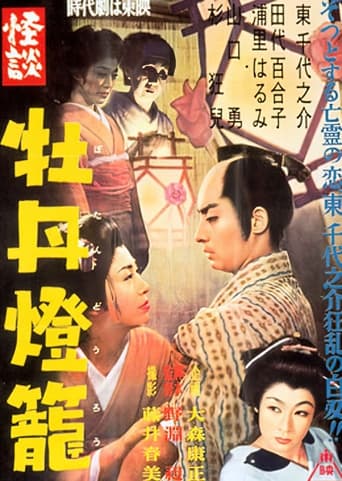kkrogstad
Also known as Kaidan Botan Dôrô, this is a classic kabuki play written by San'yûtei Enchô. Adapted to the stage for the first time in July 1892. The story is the following: The chief characters in "Botan Dôrô" are Otsuyu, a beautiful maiden in love with Hagiwara Shinsaburô. There is also the young lady's maid, and a picturesque evildoer, Tomozô.Otsuyu meeting secretly with her lover is suddenly surprised, and they are rudely parted. In despair, she commits suicide with her maid, and the ghostly shapes visit Shinsaburô nightly. A priest gives him a small golden image of the Goddess of Mercy to ward off her nocturnal visits, and puts up a charm to keep Otsuyu away. Tomozô, the hero's faithless servant, steals the image and tells his wife that the ghost of Otsuyu will appear and pay him a sum of money for hiding it, the influence of which prevents her from entering her lover's house. He is firmly convinced the ghost will appear, and his look-out for the apparition is so full of surprise and contrast, and the suspense so well sustained, that the audience is thoroughly keyed up in anticipation. Tomozô and his wife talk so much of the ghost that every moment they think she has come, and soon are trembling with fear, the frightened wife taking refuge under the large green mosquito net suspended over her bed. Otsuyu and her maid are suddenly seen to float behind the drooping branches of a willow tree, seemingly suspended in air, the maid carrying the ghostly lantern, shaped like a pink peony, that gives out a dim and intermittent glow. The transaction over between Otsuyu and Tomozô, the ghosts make their way towards Shinsaburô's house, but they cannot enter unless the Buddhist charm above the doorway is removed. This Tomozô accomplishes, and immediately as the two weird shapes vanish, a peony lantern is seen to rise mysteriously from mid-stage and without the aid of hands, sail through the air and enter an open space over the door. Shinsaburô is now left to the mercy of the ghosts, who claim him as their own and take him away from the land of the living.The story has been made many times. Botan doro [1914], Botan doro [1921], Botan doro [1924], Botan doro [1926], Botan doro [1930], Botan doro [1936], Botan doro [1968].
